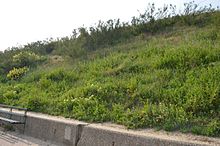Holland-on-Sea Cliff
| Site of Special Scientific Interest | |
 | |
| Location | Essex |
|---|---|
| Grid reference | TM 211167 |
| Interest | Geological |
| Area | 0.1 hectares |
| Notification | 1992 |
| Location map | Magic Map |
Holland-on-Sea Cliff is a 0.1-hectare (0.25-acre) geological Site of Special Scientific Interest in Holland-on-Sea, north-west of Clacton-on-Sea in Essex.[1][2] It is a Geological Conservation Review site.[3]
This site is of great importance in understanding the evolution of the London Basin, and it is the type site for two different gravels. The "Lower Holland Gravel" was the final terrace laid down by the River Thames before the river was diverted south during the Anglian glaciation around 450,000 years ago. The "Upper Thames Gravel" was deposited when the Thames was blocked by ice and not reaching the area. As the terraces can be attributed to the Anglian glaciation, they provide a fixed point for correlation other Anglian sequences in southern Britain and on the Continent.[1]
The site is a short stretch of the slope between the Esplanade and the Promenade, opposite Haven Avenue. No geology is visible.
References
[edit]- ^ a b "Holland-on-Sea Cliff citation" (PDF). Sites of Special Scientific Interest. Natural England. Archived from the original (PDF) on 4 March 2016. Retrieved 9 June 2016.
- ^ "Map of Holland-on-Sea Cliff". Sites of Special Scientific Interest. Natural England. Retrieved 9 June 2016.
- ^ "Holland-on-Sea Cliff (Quaternary of the Thames)". Joint Nature Conservation Committee. Retrieved 28 May 2016.
